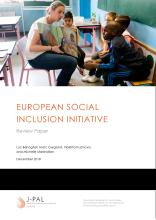European Social Inclusion Initiative Review Paper
Many Europeans still experience poverty, severe material deprivation, or difficulty in accessing regular work. The number of people at risk of poverty, after social transfers, in the EU has risen by more than five million since 2010 to close to 87 million people (Eurostat 2016).1 Social exclusion concerns all ages, but children and young adults are disproportionately affected, with approximately 27 percent of all children in Europe growing up in poverty; these rates climb to above 40 percent in some European countries, such as Bulgaria and Romania. Moreover, social exclusion is often transmitted from one generation to the next, perpetuating the cycle of disadvantage. With rising child poverty, high youth unemployment, and the recent influx of new immigrants, it is particularly important to evaluate the effectiveness of existing social programs and to develop a more comprehensive understanding of what measures can successfully lift people out of disadvantage.
